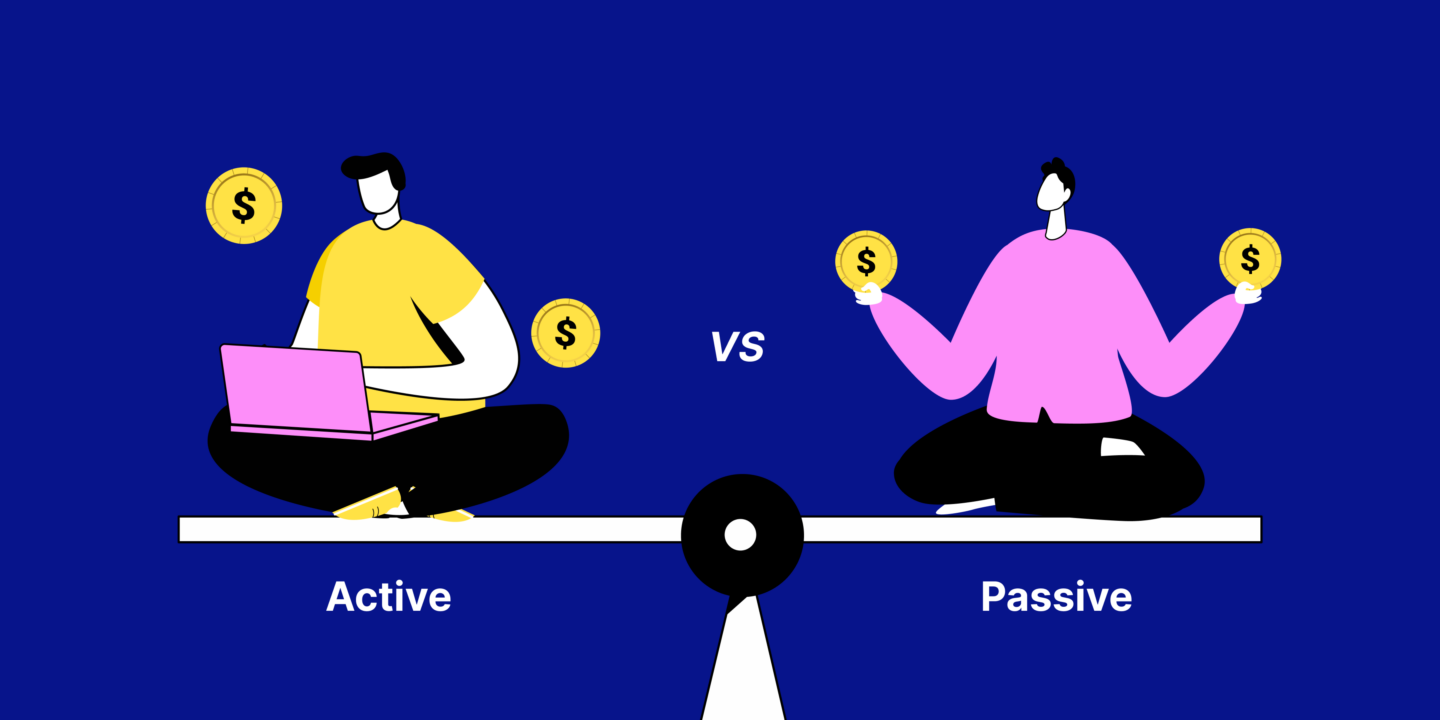
Investing, just like any other skill, takes effort, time, and experience to master. Do you know why it is easier to quote Buffett but hard to mimic him? Because he has been doing it for 80 years now. And before you lose all hope and close this tab, all to YOLO (You Only Live Once) your funds, hear me out. What if I told you that you could spend minimum time making your investment choices but still make it? Yes. That’s what we are going to talk about today- active vs passive investing.
These two investing strategies have been a topic of great interest amongst different schools of investing fraternity. But which one is better? Are there any advantages or disadvantages attached to either of them? Well, you are just about to figure that out.
What Does Active Investing Mean?
Active investing refers to the strategy where the investor actively participates in the ongoing buying and selling of assets in a bid to beat the average index returns.
Imagine a situation where you go to a carnival. There are multiple food stalls out there. And as usual, you are on a hunt to find the best available option. You have two alternatives. One, you could either pick the stalls where you see the maximum crowd, or two, you could ask for a sample from each stall and decide the best option based on your analysis.
As you might have guessed, the latter option is active investing. It is a strategy that involves frequent trading in a bid to earn beyond average returns. This technique requires a deeper understanding of the market and tools to evaluate the options.
You can either invest actively on your own or outsource it to a mutual fund manager or buy ETFs managed by experts. An active fund manager would evaluate the fundamentals of hundreds of companies, know the best entry and exit points through technical analysis and also have a fair idea of macroeconomics.
Another key difference between passive and active investors is that a portfolio designed by an active investor needs constant rebalancing. Rebalancing refers to buying/selling cryptos to suit current market conditions and maintain the desired risk-to-return ratio. If a portfolio is left unattended for a long duration, it might just go for a toss.
To sum it up, think of active investing as the one where the investor has control over the buying and selling decisions of the assets. For example, a large-cap active mutual fund manager would constantly look for alpha returns by frequently buying and selling stocks. Alternatively, a passive mutual fund manager would track an index like S&P 500 or NIFTY 50 and make sure that there are no tracking errors. That’s all.
Advantages and Disadvantages of Active Investing
We always believe that investing is all about context. There is no right or wrong here. Just people with a wider perspective and horizon. Therefore, rather than simply taking sides on these investing methodologies, let us evaluate their advantages and disadvantages.
Advantages
We love to start with positives, don’t we? So let us talk about the advantages of investing actively.
1. Flexibility
If you are actively investing, you have way more flexibility to safeguard your investments in the bouts of volatility and also to amp them up when you feel the time is ripe. An active trader can switch from bonds to equity and cash depending on the market condition and their analysis.
Above that, an active investor would likely beat the average market returns by this maneuvering. Though to reach that point is not as easy as it sounds.
2. Authority
When you invest via ETF or a mutual fund, you don’t get to tell them which company to invest in. This means you might end up funding a company indirectly, which may be against your ethics. For example, If somebody believes in climate change. It also means they will avoid investing in Nestle due to their ill practices in Africa.
But a passive investor does not have a say in all of this. While an active investor managing their own investments can make such conscious decisions.
3. Tax management
Interested in finding an absolutely legal way of avoiding taxes? It is called tax harvesting, and it involves selling your investment during the end of the fiscal year and buying them back the next day. To put this into context, the Indian government allows you to enjoy up to 1L of profits from your investments, tax-free—post which, this is subject to a long-term capital gain.
A prudent investor can sell their holdings before they breach this limit and buy it back again the next year to reduce their tax liability.
While a passive investor can also do it, an active investor can be way more innovative when deploying such techniques.
Disadvantages
Well, it’s not all hunky dory either for an active investor. Here are some of the downsides of active investing.
1. Increased risk
When your bets are up to the mark, you tend to win big. However, there is a flip side to this as well. If you are trading on margin without proper risk management, you could lose in an equal proportion.
2. Learning Curve
And if you consistently want to make good returns, you need to learn, unlearn and relearn constantly. It takes a lot of practice and understanding of the market to constantly make smart bets. And doing this does take time. Therefore, if you are already late to the investing bandwagon, active investing may not be the correct mode of entry for you.
3. Expense ratio
If you plan to invest in an actively managed mutual fund, you are exposing yourself to an expense ratio as well, which is generally higher than in passive funds. This difference might be enough to dent your portfolio by a few lacs as you approach your target or maturity.
4. Psychological impact
If you are actively involved with your portfolio, you might end up being tricked into optimizing for higher returns or lower costs. However, in reality, you should optimize for time. The time spent in the market is way more important than timing the market. Therefore, one needs to be mindful of their decisions.
What Does Passive Investing Mean?
Passive investing, as the name suggests, is a technique of investing in assets for the long term that does not require constant monitoring. I’ll help you with an example here. Say you are bullish on crypto in general but do not understand how individual cryptocurrencies work. So instead, you find an index of such funds that track all the blue-chip cryptocurrencies. This way, all you are doing is gaining exposure to the best cryptocurrencies by market cap and, therefore, the larger market without actively buying and selling standalone assets.
Now, if the general market goes up, so will these assets and vice-versa. Even if you buy and forget and don’t pay much attention to these assets, you are through. Because you literally invested in a basket that represents your interest.
Another example is from the stock world. There is a mutual fund called Navi Index Fund Nifty 50. This fund simply tracks the Nifty 50 index, which is the weighted average of the top 50 companies listed in Nifty. Say you invest Rs. 100 in this fund, it automatically gets allocated to the top 50 companies as per their weight in the Nifty 50.
I believe passive investing should be a go-to mode for anyone who is just exploring this realm and wants to quickly start the investing journey as soon as possible.
Advantages and Disadvantages of Passive Investing
While passive investing may sound like an easy way to invest your money, it does have some subtle nuances. Thus it’s important to evaluate the advantages and disadvantages of passive investing.
Advantages
Let us first talk about a clear edge that passive investing has over our good old active investing. This will pave the way for a conversation about its downsides in the next section.
1. Costs
If you compare the total expense ratio for passively managed mutual funds and actively managed funds, you will find a huge difference in the total costs. This is because, for an index fund (passive fund), the fund manager isn’t picking the stocks to invest in. They simply invest in the top companies in the market.
Here’s one often-ignored benefit of passive mutual funds. You see, the entire alpha (incremental returns over average) is generated by the fund manager through research and information that the general public does not have access to. But for actively managed large-cap mutual funds, this is not the case. These are often big companies that are constantly in the public eye. As a result, it is difficult for these actively managed funds to beat the index. Therefore, you are better off investing in an index fund as compared to actively managed large-cap mutual funds because the expense ratio is minimum in the former.
2. Transparency
When you go passive, you are almost certain which assets your money is going to. Of course, actively managed funds reveal that as well but tracking the frequent removal and addition of assets becomes difficult.
3. Lesser hassle
If you are a buy-and-forget kind of investor, this is the way to go. Investing passively takes minimal effort and often generates average returns in the long run. It is truly a reflection of spending more time in the market rather than losing your sleep over chasing that alpha.
Disadvantages
Wondering what could be the downsides of chilling and making your money work?
1. Exit strategy
Since passive investing revolves around the buy-and-forget strategy, one may fail to consider the exit strategy during a severe downfall. Yes, markets do recover after each downfall, but the time horizon cannot be predicted for the same. It may impact your near-term goals.
Active Vs Passive Investing: Key Differences
For our beloved short attention span clan, here is a quick summary of the key differences between active and passive investing.
| Parameter | Active Investing | Passive Investing |
| Frequency and Involvement | The fund manager actively participates in the market and tries to change the composition of the portfolio depending on the trends. | Investor tries to copy the movement of the key indices. The assets and the weights are decided by the index. |
| Expenses | And because someone is literally spending their life nitpicking the right stocks, actively managed mutual funds have a higher total expense ratio. | Since the job is to allocate funds in a pre-defined template, the expense ratio is among the lowest in the industry. |
| Returns | The entire aim of active investing is to beat the average returns generated by the index. Else, why would you spend so much time and money on researching? | Passive investing aims for average returns at par with the index. |
Conclusion
I think before we jump into the black-and-white categorization of good and bad in each of these strategies, it is important to understand that there is a reason they call it ‘personal finance’. Depending on your risk appetite, understanding of the market, and willingness to learn, you may pick either of these strategies.
However, one good way to approach this realm is to start investing passively and slowly move towards active investing as you get involved. And one sure way of winning at passive investing is to invest in themes instead of individual cryptos. Coin Sets by Mudrex allows you to do exactly that.
FAQs
1. Which yields a greater return- active or passive investing?
Ideally, active investing should yield a greater return. The entire aim of investing actively is to find ways to beat the average market returns. If your active investments do not yield higher returns, they need to be re-evaluated because you would have been better off investing passively.
2. How effective is passive investing in India?
In the current global economic scenario, India has emerged as a strong player. With all global currencies tumbling against the dollar, INR has held its ground comparatively. Therefore, investing in Indian indices is a good way to ensure decent returns in the long run.
3. In India, what is a reasonable expense ratio?
The expense ratio varies based on active/passive mutual funds. Also, it depends if you are investing in equity or debt-based instruments. For a quick reference, here are SEBI norms for setting a total expense ratio.




